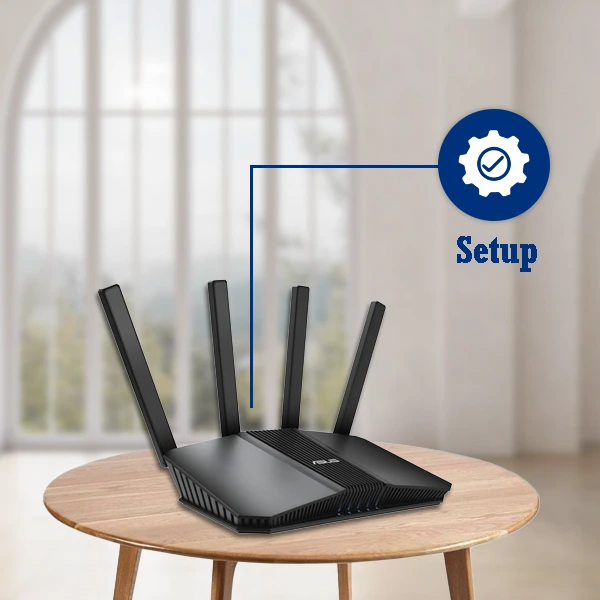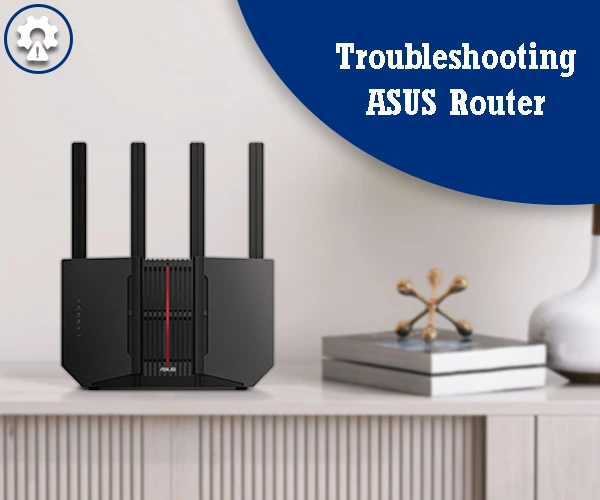ASUS Router Configuration Guide: Detailed Step-by-Step Directions for Maximum Efficiency
For dependable fast internet access across your house or place of business ASUS router must be configured correctly. This article will guide you through every step of the ASUS router setup procedure including more complex setups like PPPoE Bridge Mode and IPv6 regardless of whether you are a novice or are upgrading your network. Additionally, we will diagnose common problems and offer advice on how to get the most out of your router.
Typical ASUS Router Configuration setup Procedure
There are a few crucial stages involved in configuring a new ASUS router. The normal procedure to begin how to setup asus router:

Open the package and connect the hardware.
- After taking your asus router setup out of the box plug in power adapter.
- Use an Ethernet to connect your modem to the router’s WAN (internet) port.
- Turn on the modem and router.
Join the router network.
- Connect wirelessly using the default network name (SSID) and password listed on the router label or use an Ethernet wired connection.
- Formerly you begin configuring validate that your computer or smartphone is associated.
Go to the login page for the ASUS router.
- In the address bar of a web browser type either http://192.168.1.1 or http://router.asus.com.
- To log in enter default username and keyword which are often admin.
Open the ASUS Configuration Wizard.
- The ASUS setup wizard will automatically walk you through the first configuration steps when you log in.
- Establish a Wi-Fi SSID choose your internet type and choose a secure password.
Save and Use the Configurations
- Apply and save the modifications after the router asus setup process is finished.
- The network will be operational when your router has automatically rebooted.
Advice: To guarantee security and compatibility keep your firmware updated.
Utilizing the ASUS Configuration Wizard
The purpose of the ASUS setup wizard is to make router setting easier. Here’s how to make good use of it:
Open the Setup Wizard.
- Go to ASUS router login page by opening your browser.
- Click “Start Setup Wizard” if asked.
Choose the Type of Internet Connection.
- The majority of ISPs provide PPPoE static IP or dynamic IP (DHCP).
- Select the kind that your ISP offers.
Configure Wi-Fi
- Choose an easily recognizable network name (SSID).
- Use a combination of letters numbers and symbols to create a strong password.
- Select the kind of security (WPA2 or WPA3 are suggested).
Complete the setup
- After reviewing the summary page select “Apply.”
- Await the reboot of the router.
Note: Try cleaning your browser’s cache or switching to a new browser if the asus router setup process is stuck or won’t start. It can also be supportive to reset the router.
ASUS router setup PPPoE connection guide
Point-to-Point Protocol over Ethernet or PPPoE is frequently utilized for fiber or DSL connections. To establish a PPPoE connection take the following actions:
Go to the router’s settings
- Use http://router.asus.com to access your ASUS router.
Go to the WAN Settings.
- Navigate to WAN under Advanced Settings.
- Choose PPPoE as the WAN connection type.
Put in your ISP login information.
- Enter the password and username that your ISP has given you.
- To ensure constant connectivity turn on Reconnect Automatically.
Reboot and save the settings.
- To save the changes click Apply.
- Validate that your internet connection is functioning correctly by testing it.
Advice: Check the physical connection to the modem and confirm your login information if your router displays “No Internet” after configuration.
ASUS router IPv6 setup configuration
The newest internet protocol IPv6 was created to supplement IPv4 and offer extra IP addresses. IPv6 configuration enhances interoperability with contemporary networks.
Open the IPv6 Configuration
- Go to Advanced Settings > IPv6 after logging into your router.
Select the Type of Connection
- There are three options: 6to4 tunnel Native and Passthrough.
- Choose Native IPv6 if it is available; most ISPs offer it.
Use the Settings
- To save the changes click Apply.
- Use an online IPv6 test to confirm your IPv6 connectivity.
Tip: To guarantee network compatibility in the future keep IPv6 enabled.
How to setup ASUS router bridge mode
By extending an existing network without establishing a new subnet Bridge Mode enables your ASUS router to function as an access point.
Router Interface Access
- Use http://router.asus.com to log in.
Go to the Administration Settings.
- Navigate to Administration > Operation Mode under Advanced Settings.
- Choose the Access Point (AP) Mode option.
Link to the primary router
- To link the ASUS router to your main router, use an Ethernet wire.
- Within the range of the main network assign an IP address.
Install and restart
- Restart the router after saving the changes.
- The current network will now be extended by the ASUS router acting as a bridge.
Advice: To avoid connectivity problems do not use Bridge Mode with double NAT.
Solving Typical ASUS Router Problems
Even with the right asus router setup you may run across frequent problems:

ASUS router login page not opening after setup
- You need to confirm the linking of devices.
- In the event that router.asus.com is unavailable use the IP address 192.168.1.1.
- Temporarily turn off your firewall or VPN.
ASUS router says no internet after setup.
- Validate that the WAN cable is firmly attached.
- Verify the PPPoE ISP credentials are accurate.
- Restart the router and the modem.
The asus router setup Wizard Will Not Start
- Try a new browser or eradicate the cache in your existing one.
- Validate that JavaScript is on.
- If the problem continues reset the router.
Poor Wi-Fi Signal
- Place the router in the middle.
- Keep away from metal items and walls.
- For fast devices use the 5GHz frequency; for long-range coverage use the 2.4GHz band.
Comprehensive Advice regarding ASUS Router Performance
Updates for Firmware
- Update the firmware on a regular basis by selecting Administration > Firmware Upgrade.
- Updates enhance feature support security and stability.
Configuring QoS (Quality of Service)
- Give gaming and streaming bandwidth priority.
- Go to Bandwidth Management > Adaptive QoS.
Configuring the Guest Network
- Allow visitors to use a different Wi-Fi network.
- aids in keeping your core network secure.
Controls by Parents
- Control device internet access.
- For improved security and monitoring use AiProtection.
Traffic Surveillance
- To track bandwidth utilization, use Traffic Analyzer.
- Regulate which devices are using too much data.
Network security fast internet and smooth connectivity are all guaranteed by a properly configured ASUS router. You may fix common difficulties and asus router setup on your router for IPv6 PPPoE conventional internet connections or even Bridge Mode by following these instructions. Optimizing your network’s performance and dependability may be achieved through sophisticated settings like QoS appropriate location and routine firmware updates.
FAQs
What is the standard process for setting up a brand-new ASUS router?
To finish the installation, connect the router to your modem go to the login page follow the asus router setup instructions adjust the Wi-Fi settings save your changes and reboot.
My setup wizard is stuck or won't launch. What should I do?
To regain access to the ASUS setup process, clear the cache on your browser use a different browser validate that JavaScript is enabled turn off your VPN or reset your router.
How do I set up my ASUS router for a PPPoE connection (common with DSL/Fiber)?
To activate the connection go to WAN settings, choose PPPoE input your ISP’s username and password turn on auto-reconnect save the configuration and restart the router.
How do I configure my ASUS router for Bridge Mode (Access Point/AP)?
Go to Administration > Operation Mode choose Access Point Mode establish an Ethernet connection to the primary router assign an IP address apply configurations and restart.
How do I set up my ASUS router for IPv6?
Access the IPv6 settings in Advanced Setup choose the connection type that your ISP has supplied (often Native) activate IPv6 make the necessary adjustments and test the IPv6 connectivity of your network.